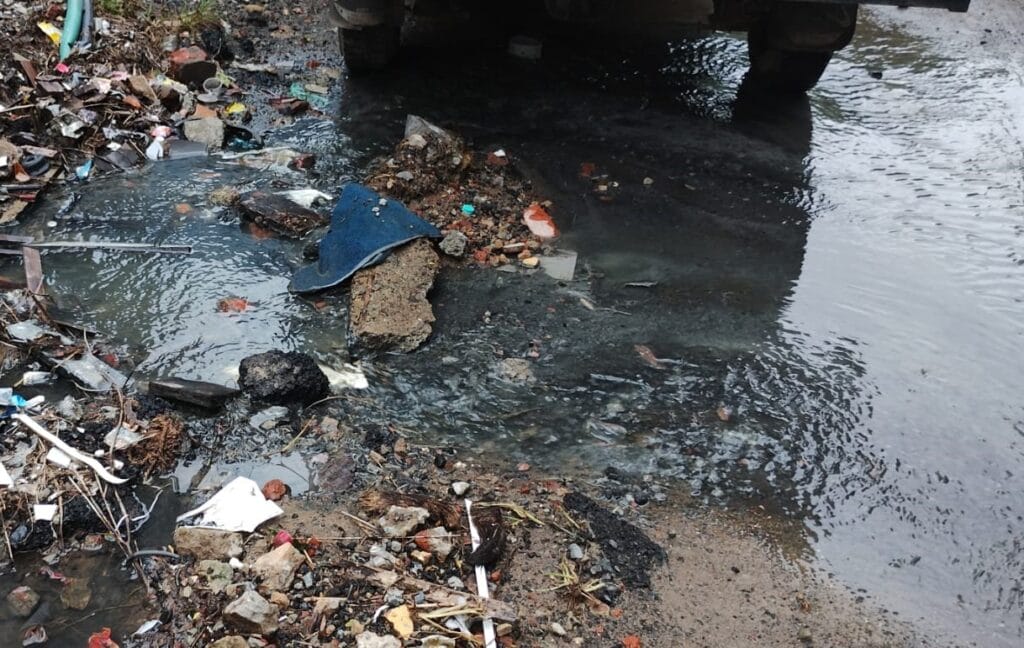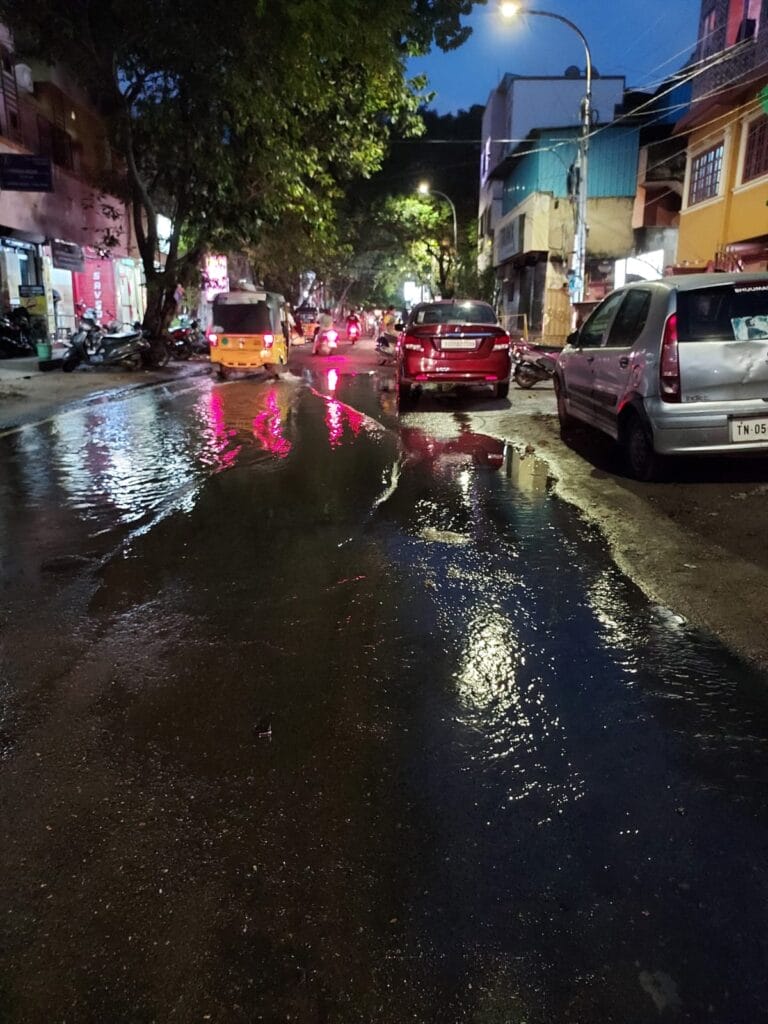Every year, November and December have been the most devastating months for Chennai when it comes to natural calamities. Our city has long been known for its susceptibility to a long list of natural disasters: cyclones, storm surges, coastal flooding, torrential rainfall, earthquakes and tsunamis. After the 2015 deluge in Chennai, the then administration had acknowledged the fact that the incomplete Storm Water Drainage (SWD) network was one of the main reasons for the disaster, which claimed over 470 lives.
Most of the problems faced by the residents in Chennai have existed for decades. Inadequate and poorly managed basic infrastructure has resulted in sewage overflow on the streets, blocked drains and overburdened SWD and sewage networks. In Oct 2020, the Greater Chennai Corporation (GCC) had claimed they were on the verge of completing the ₹440-crore SWD project, which was started in 2018. During this period there were reports that the civic body was working without a map of the entire network of drains in Chennai.
Money down the drain

Read more: Perambur SWD construction: Sewage, exposed cables and other horrors
Several crores of taxpayer’s money is being spent every year to desilt and restore existing drains and construct new stormwater drains across the city. Every year, before the onset of the monsoon in Tamil Nadu, officials as well as elected representatives of the GCC have been issuing a statement that 90 to 95% of the storm water drain construction works have been completed and there would be no more flooding in the neighbourhoods. Recent flooding across the city vindicates the fact that nothing has changed over the years despite crores of a rupees being spent on the drains.
In the middle of last year, the local administration chose to advance the desilting of the existing storm water drains in the city. Workers drawn from the MGNREGA scheme were deployed to remove the silt from all the drains in preparation of the monsoon. The distance between two manhole chambers is normally 9–10 feet and the workers were unable to clean the muck/debris within the drains entirely. When we noticed that the work was being executed in a shoddy manner in Gurumurthy Garden Street and School Road, we immediately intervened and spoke to the local officials. It was decided to cut the top of the drain in between the two manhole doors to facilitate desilting and the work was done, in bits and pieces.
When they attempted to cut open the top of the drains to desilt the same, the brick walls supporting the top cover of the drain started collapsing in several locations. We noticed the problem and escalated the matter to our elected representative and the local officials. When they realised that the existing SWD was in a very bad condition they chose to close the open pits with custom-made concrete slabs as a temporary measure. It was nothing more than a cosmetic makeover. We were hopeful that the issue would be addressed after the monsoon, but nothing has been done over the last one year to restore the entire stretch of the SWD on this road.
State of drains in Perambur
Many roads in Ward 71, Zone 6, Perambur are either waterlogged or stinking of sewage after the recent rains, because of incomplete work done by the authorities in the previous years. The unsanitary conditions on the roads due to sewage overflow pose a risk of health hazards for the residents. Let us take Patel Road in this area as a case study. The GCC workers had desilted only a small stretch of the SWD in mid-2022.

A few days ago, there was waterlogging near the Patel Road and Bharathi Road intersection inconveniencing commuters and pedestrians, so we decided to review the issue. Here is what we found and reported. The irony is that it had not rained over the past few days. Illegal sewage connections into the SWDs is no secret. The residents’ association members from the locality have been reporting it all the time. Lack of proper coordination, nexus between the contractor cartels and officials, political interference and widespread corruption is to be blamed for this menace.
Venkatraman Street in Ward 71, Zone 6 is another example that we would like to sight — desilting of the SWD was done in mid-2022, again only in bits and pieces. Several residents have constructed ramps which extend five to six feet over the drains. The chamber doors cannot be accessed and therefore the MGNREGA workers had only cleaned the chambers where they were able to locate the doors. This year the drains in Patel Road and Venkatraman Street have not been desilted and water logging can be noticed after the rains.
Read more: Living with sewage: Fishing hamlets in Chennai’s Kottivakkam see no end to drainage woes
Shoddy work everywhere
At Vadivelu Main Road, in Ward 71, Zone 6, a stretch of the SWD is in a horrible condition — broken and missing chamber doors, drain filled with debris and muck. In Muniappan Street, Ward 44, Zone 4, the road was milled and left behind for over 6 months, a new SWD was constructed and the sewage drains were also replaced. The work was done in such a shoddy manner that the sewage was seen overflowing on to the street and entering the Silt Catch pits related to the SWD. Many silt catch pits in our neighbourhood has a RWH facility (viz: a 10-feet borewell). With sewage getting drained into the silt catch pit, it was only contaminating the ground water. This issue was reported last year.
Despite bringing these issues to the notice of the authorities several times over the last one year, nothing has been done to address the problems we have been facing. The unskilled workers drawn from MGNREGA were not well-equipped to open the manhole chamber doors without damaging them. It is important to note that the SWD drains were not been opened or desilted for decades and the doors were jammed. The workers were seen breaking the SWD manhole doors with crowbars and desilting only a small stretch of the drains manually. After the desilting work was completed, the open chambers were closed with plyboards and polythene bags filled with debris. We had to lodge several petitions in order to draw the attention of the local administration and get them to provide new doors. While some of the missing doors were replaced, there are others, which are yet to be replaced despite several reminders.
Take the storm water canal on Perambur High Road North Side. The entire stretch of the SWD between Perambur and Vyasarpadi Jeeva railway stations is today in a very dilapidated condition. After we lodged several complaints and reported the matter through the mainstream media, a small stretch of the SWD was repaired. The concrete slabs which were placed over casuarina poles and iron channels are in a dilapidated condition within a year and are bound to crash anytime soon. Given the large amount of taxpayer’s money involved, residents expect that the authorities would be more accountable and fix the problems soon.
If you have waterlogging/SWD issues in your area, contact GCC/CMWSSB helpline numbers 1916 and 044-45674567.
Here is what needs to be addressed by the GCC/CMWSSB urgently:
- The damaged SWDs in Ward 71, Zone 6 especially in Patel Road, Nelvayal Road, Vadivelu Main Road, Chinnayan New Colony 1st and 2nd Main Road, Anandavelu Street and Perambur High Road North Side must to be restored entirely.
- Desilting of the drain in Venkatraman Street must be done properly. The residents must be asked to provide proper manhole doors over the ramps they have constructed on top of the SWD.
- Silt catch pits, vents and RWH facilities need to be cleaned up at regular intervals to ensure their purpose is served.
- Local officials and elected representatives should make an attempt to engage with the local communities and monitor the condition of the SWD and Sewage Drains at least once in 6 months or before the onset of the monsoon.
- We suggest that the capacity of the Sewage Pumping Station be increased bearing in mind the increase in population and the fact that sewage is being drained into SWD and vice versa.
- The purpose of having separate drainage networks for sewage and storm water being served in all earnest.
Also read:
This Chennai apartment’s self-sustaining sewage treatment plant a model to emulate
Sewage lorries polluting Chennai lakes, drains with impunity